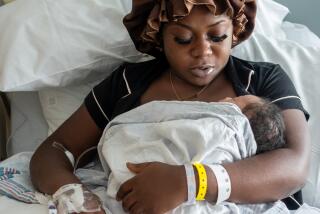Infants Have Latest Medical Technology in Their Corner
- Share via
In the hushed confines of one of the most sophisticated medical care units in the nation, in a web of spaghetti-like catheters and intravenous feeding tubes and digital heart monitors, Patti and Samuel Frustaci’s six tiny infants are struggling for their lives.
It is an uphill battle. The chances that they will live are barely 50%. Born nearly three months before a normal baby leaves the womb--some of them weighing only a little more than a pound--they would be among the smallest infants ever to survive.
The battle is waged not only against potential infection from the outside world, which their immune systems are not yet prepared to combat, but against their own lungs, which have not developed fully.
Yet nearly 25 years of modern research in neonatalogy and some of the most advanced medical technology are available to help. The neonatal intensive care unit at Childrens Hospital of Orange County, home for the next three to four months for the Frustaci babies, is one of about 18 centers in California capable of providing the highest possible level of care to premature, sick and malformed infants who otherwise might have little or no chance of survival.
In the last five years alone, thanks to the development of more sophisticated monitoring equipment, medication and surgical techniques and to the improvement in prenatal care for high-risk mothers, doctors’ ability to protect the lives of premature infants has improved considerably. Gains in the last two decades have been dramatic.
“When we started out, we could treat infection, we could do some nutritional things, but really, the reality for babies who weighed much under five pounds was that they simply didn’t survive,” said Dr. Louis Gluck, head of the neonatal care unit at the University of California, Irvine, and founder of the first such center, at Yale University, in 1960.
“Three and a half pounds was considered to be an absolute minimum, but through the years, we’ve seen an absolute revolution,” he said. Now, doctors predict a 70% to 75% survival rate for babies near two pounds, with 80% to 90% of those growing to normal adulthood with no complicating aftereffects.
The six survivors will be watched by a team of six neonatalogists, plus full-time nurses and respiratory therapists, 24 hours a day for the slightest breathing irregularity or abnormal blood level.
There is an overwhelming stillness in the ward. There are no infant shrieks. Nurses and parents travel the ward in surgical gowns and gloves. Occasionally, the pulse of an alarm breaks the stillness, notifying nurses that one of the babies has stopped breathing. Often, a gentle nudge will restore normal respiration.
Blood Transfusions
In many respects, the Frustaci babies have already exhibited symptoms common to premature babies. Four have required blood transfusions because of low blood pressure. And although their mother had been given steroids a few days before delivery to accelerate development of their lungs, all have developed severe hyaline membrane disease, a lack of the sticky substance known as “surfactant” normally secreted in newborns’ lungs that prevents them from collapsing on themselves.
Neonatalogists--pediatricians who have studied the care of high-risk infants for two extra years--are working on new treatments for the disease, which killed former President John F. Kennedy’s premature infant in the early 1960s.
Gluck said doctors at that UC Irvine Medical Center were successful very recently in isolating surfactant, which normally developing fetuses produce, from the amniotic fluid of a healthy baby and dripping it through the windpipe of a premature infant, nearly instantly increasing the baby’s oxygen level.
“Here we have babies that are near (full) term treating their premature friends,” Gluck said.
Though neonatal care centers are equipped to deal with all high-risk newborns--those suffering from life-threatening birth defects, severe infections or birth asphyxia--premature babies make up about 75% of the caseload in neonatal medicine, and the caseload is large. Childrens Hospital averages about 500.
Parental Involvement
“The newborn baby in the last 10 years has achieved the status of an older person who has had a heart attack. He gets as good or better care,” said Dr. Ralph Rucker, who is caring for the smallest of the Frustaci babies--a 1-pound, 1-ounce boy.
A key ingredient in most modern neonatal care is involvement of the parent, particularly the mother--fondling the infant, talking soothingly and, in later stages of development, breast-feeding when possible.
Doctors have long recognized that a baby responds to its mother’s voice--recalled, perhaps, from before birth--in a positive way that has nothing to do with medical technology.
“We recognized very early how important parents are to the therapy of these babies,” said Gluck, one of the pioneers in including parental involvement in neonatal care. “No matter how small they are, they seem to understand the mother’s touch, the mother’s voice, the mother’s smell, as different from anybody else’s, and they seem to do better when it is there.”
Patti Frustaci will not be able to see her six babies for at least two days, when she is released from the intensive care unit, hospital officials said.
Even after the babies are released from the hospital, the danger is not over. Premature infants run a higher risk of sudden infant death syndrome, in which they simply and inexplicably cease to breathe.
Premature children also run a greater-than-normal risk of mental retardation or cerebral palsy stemming from complications that occur shortly after birth.






